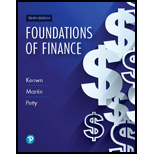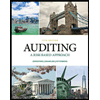
EBK FOUNDATIONS OF FINANCE
10th Edition
ISBN: 9780135160473
Author: KEOWN
Publisher: PEARSON CO
expand_more
expand_more
format_list_bulleted
Question
Chapter 16, Problem 1MC
Summary Introduction
Case summary:
Person X is a business reporter in local newspaper; he asked to put together a series of articles relating to multinational finance and international currency markets for their readers.
The recent coverage has been given to losses in foreign exchange market by Company J a local subsidiary of Company D (Large Country G firm). X’s editor would asked to address several specific questions relating to international finance.
To discuss: Additional factors and problems that are encountered in international
Expert Solution & Answer
Want to see the full answer?
Check out a sample textbook solution
Students have asked these similar questions
I mistakenly submitted blurr image please comment i will write values.
please dont Solve with incorrect values otherwise unhelpful.
When should a company buy back stock? no ai.
What is the market risk premium?Explain .
Chapter 16 Solutions
EBK FOUNDATIONS OF FINANCE
Ch. 16 - Prob. 1RQCh. 16 - Prob. 2RQCh. 16 - What is meant by arbitrage profits?Ch. 16 - Prob. 4RQCh. 16 - Prob. 5RQCh. 16 - Prob. 6RQCh. 16 - Prob. 7RQCh. 16 - Prob. 8RQCh. 16 - Prob. 9RQCh. 16 - Prob. 1SP
Ch. 16 - Prob. 2SPCh. 16 - Prob. 3SPCh. 16 - Prob. 4SPCh. 16 - (Exchange rate arbitrage) You own 10,000. The...Ch. 16 - Prob. 6SPCh. 16 - Prob. 7SPCh. 16 - Prob. 8SPCh. 16 - Prob. 9SPCh. 16 - Prob. 10SPCh. 16 - Prob. 11SPCh. 16 - (Purchasing-power parity) Lets assume a McDonalds...Ch. 16 - Prob. 1MCCh. 16 - Prob. 2MCCh. 16 - Prob. 3MCCh. 16 - d. What are the differences among a forward...Ch. 16 - Prob. 5MCCh. 16 - Prob. 6MCCh. 16 - Selling Quotes for Foreign Currencies in New York...Ch. 16 - Prob. 8MCCh. 16 - Prob. 9MC
Knowledge Booster
Learn more about
Need a deep-dive on the concept behind this application? Look no further. Learn more about this topic, finance and related others by exploring similar questions and additional content below.Similar questions
- Hello I mistakenly submitted blurr image please comment i will write values. please dont Solve with incorrect values otherwise unhelpful.arrow_forwardTell me why each of the financial statements by themselves is inadequate for evaluating a company?arrow_forward3. What are some pros and cons of market value?arrow_forward
- All else equal, should the WACC be higher for a company with a $100 million market cap or a $100 billion market cap?arrow_forwardWhat are some common methods PE firms use to increase portfolio company value?arrow_forwardWhy do you believe you will be a competent investment banking analyst?arrow_forward
arrow_back_ios
SEE MORE QUESTIONS
arrow_forward_ios
Recommended textbooks for you
- Business/Professional Ethics Directors/Executives...AccountingISBN:9781337485913Author:BROOKSPublisher:Cengage
 Intermediate Financial Management (MindTap Course...FinanceISBN:9781337395083Author:Eugene F. Brigham, Phillip R. DavesPublisher:Cengage Learning
Intermediate Financial Management (MindTap Course...FinanceISBN:9781337395083Author:Eugene F. Brigham, Phillip R. DavesPublisher:Cengage Learning 
 Auditing: A Risk Based-Approach (MindTap Course L...AccountingISBN:9781337619455Author:Karla M Johnstone, Audrey A. Gramling, Larry E. RittenbergPublisher:Cengage Learning
Auditing: A Risk Based-Approach (MindTap Course L...AccountingISBN:9781337619455Author:Karla M Johnstone, Audrey A. Gramling, Larry E. RittenbergPublisher:Cengage Learning Cornerstones of Financial AccountingAccountingISBN:9781337690881Author:Jay Rich, Jeff JonesPublisher:Cengage Learning
Cornerstones of Financial AccountingAccountingISBN:9781337690881Author:Jay Rich, Jeff JonesPublisher:Cengage Learning


Business/Professional Ethics Directors/Executives...
Accounting
ISBN:9781337485913
Author:BROOKS
Publisher:Cengage

Intermediate Financial Management (MindTap Course...
Finance
ISBN:9781337395083
Author:Eugene F. Brigham, Phillip R. Daves
Publisher:Cengage Learning


Auditing: A Risk Based-Approach (MindTap Course L...
Accounting
ISBN:9781337619455
Author:Karla M Johnstone, Audrey A. Gramling, Larry E. Rittenberg
Publisher:Cengage Learning

Cornerstones of Financial Accounting
Accounting
ISBN:9781337690881
Author:Jay Rich, Jeff Jones
Publisher:Cengage Learning
Business Diversification; Author: GreggU;https://www.youtube.com/watch?v=50-d__Pn_Ac;License: Standard Youtube License